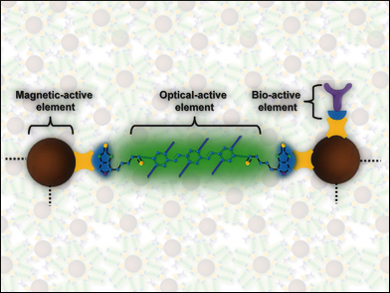Micro-sized Colloids for Cell Sorting
Nanotechnology has been a major focus of materials scientists and chemists over the last couple of decades, but, to paraphrase Richard Feynman, there is even more room at the bottom. Specifically, science must not ignore the realm of microscopic entities that can be made and functionalized from the bottom up. Researchers in China have taken this notion to heart by creating multitasking colloidal particles that exist not in the nanoscopic realm, but on the scale above that.
Shu Wang and colleagues, Beijing National Laboratory for Molecular Sciences, Institute of Chemistry at the Chinese Academy of Sciences, Beijing, China, have investigated self-assembling micrometer-sized magnetic colloids (pictured) that have multifunctionality. The biotinylated oligo (p-phenylene vinylene) (OPV) derivative gives the units the necessary properties to self assemble into microscopic magnetic beads, with attendant streptavidin units. Among their properties are magnetic, optical and biological activities. The magnetic functionality of the colloids means they can be used for cell sorting. The optical-active element endows them with fluorescence so they can be observed.
Chemically, biotin is an ureido (tetrahydroimidizalone) ring fused with a tetrahydrothiophene ring with a valeric acid substituent. It is a well-known coenzyme and is commonly used in biotechnology to attach proteins and other biological molecules to different materials without interfering with the function or the form of the protein. Streptavadin is a protein extracted from the bacterium Streptomyces avidinii. Its interaction with biotin is remarkably strong. In biotechnology, it is widely used in purification and detection of biomolecules.
The team points out that the optical element (OPV derivatives) facilitates fluorescence imaging to trace the assembly process. The bioactive element (antibody) allows these particles to home in on target cells of interest in a particular biomedical experiment or diagnostic procedure. Compared to other methodes, no cell modification is necessary here. The amplified magnetic properties of the colloidal assembly allow for better cell isolation when compared to the use of conventional monodisperse colloids.
Multifunction by Simply Changing the Functional Ingredients
The fact that their colloidal particles are of a similar size to the cells being investigated – as opposed to being orders of magnitude smaller like nanoparticles – means that investigations are not only simplified in terms of imaging, but the size of the particles makes it much easier to incorporate several functions into them simultaneously. Different combinations of functions will be possible with the next generation of such particles, the team suggests. By simply changing the functional ingredients they hope to build new micrometer-sized bead assemblies with diverse multifunctional applications in the future.
Chenyao Nie further explains the relevance of the work to ChemistryViews.org: “Unlike the well-studied nanometer-sized structures, micrometer-sized ones so far have rarely been of concern. We hope our work will lead to more attention being paid to this area and open new doors to applications given their unique properties.” He adds that, “We realized multifunctionality in a system by a bottom-up approach without complicated modification steps. This system could be used for different new applications by simply changing the functional elements. Its universal property makes it a promising system for more multifunctional materials.”
Joerg Lahann of the University of Michigan, Ann Arbor, USA, is enthused by this latest research into functional particles: “Multifunctional particle systems, which combine unusual properties as described by Nie et al., are at the forefront of particle engineering,” he told ChemistryViews.org. “Potential applications are vast, and may range from diagnostics and sensors to drug delivery. The particular system described by Nie et al. combines magnetic, biological and optical properties in a particularly instructive way.”
- Multifunctional Assembly of Micrometer-Sized Colloids for Cell Sorting,
Chenyao Nie, Bing Wang, Jiangyan Zhang, Yongqiang Cheng, Fengting Lv, Libing Liu, Shu Wang,
Small 2015.
DOI: 10.1002/smll.201402970




